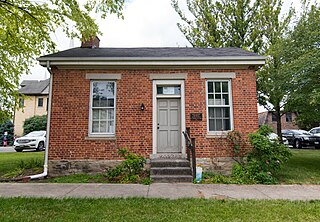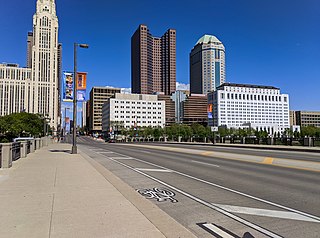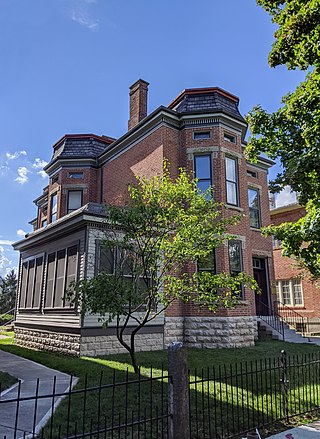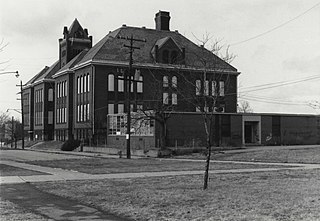
Downtown Columbus is the central business district of Columbus, Ohio. Downtown is centered on the intersection of Broad and High Streets, and encompasses all of the area inside the Inner Belt. Downtown is home to most of the tallest buildings in Columbus.

Columbus City Hall is the city hall of Columbus, Ohio, in the city's downtown Civic Center. It contains the offices of the city's mayor, auditor, and treasurer, and the offices and chambers of Columbus City Council.

The Central Ohio Fire Museum is a firefighting museum in downtown Columbus, Ohio. The museum is housed in the former Engine House No. 16 of the Columbus Fire Department, built in 1908. It was listed on the Columbus Register of Historic Properties in 1983 and the National Register of Historic Places in 1995.
The Columbus Register of Historic Properties is a register for historic buildings and other sites in Columbus, Ohio, United States. The register is maintained by the City of Columbus Historic Resources Commission and Historic Preservation Office, and was established in 1980. Many of these landmarks are also listed on the National Register of Historic Places, providing federal tax support for preservation, and some are further designated National Historic Landmarks, providing additional federal oversight.

The General William Henry Harrison Headquarters is a historic building in the East Franklinton neighborhood of Columbus, Ohio. It was listed on the National Register of Historic Places in 1972 and the Columbus Register of Historic Properties in 1985. The brick house was built in 1807 by Jacob Oberdier, one of Franklinton's first settlers. The house became especially important to the area from 1813 to 1814, when General William Henry Harrison, later the 9th President of the United States, used the house as his headquarters. It is the only remaining building in Ohio associated with Harrison.

The Krumm House is a historic building in the Brewery District neighborhood of Columbus, Ohio. It was listed on the National Register of Historic Places and Columbus Register of Historic Properties in 1982. The brick house was built c. 1885. The building was home to Alexander W. Krumm, the Columbus City Solicitor from 1878 to 1883. The property is also one of few remaining late 19th century houses on South High Street.

The Columbus Civic Center is a civic center, a collection of government buildings, museums, and open park space in Downtown Columbus, Ohio. The site is located along the Scioto Mile recreation area and historically was directly on the banks of the Scioto River.

The Sullivant Land Office is a historic building in the East Franklinton neighborhood of Columbus, Ohio. It was listed on the National Register of Historic Places in 1973 and the Columbus Register of Historic Properties, along with the Gen. William Henry Harrison Headquarters, in 1985. The small brick building was built c. 1822. Its original use was as a single-room real estate office, although it was later expanded. At the time of construction, Lucas Sullivant was selling and giving away pieces of land, and Franklinton became the county seat of Franklin County. The building is the only remaining structure associated with Lucas Sullivant in the Franklinton area. In the early 1980s, the Columbus Recreation and Parks Department moved the building from its original location at 714 W. Gay St. to 13 N Gift St., behind the William Henry Harrison house. The move was prompted because the building was endangered in its original location, with vandalism, deterioration, and plans to create a parking lot for a car dealership on the site.

The North Market Historic District is a historic district in Downtown Columbus, Ohio. The site was listed on the National Register of Historic Places in 1982 and the Columbus Register of Historic Properties in 1983. The district consists of two-to-four-story warehouses, dating from 1880 to 1910.

Columbus Public Health is the health department of Columbus, Ohio. The department is accredited by the Public Health Accreditation Board. The department dates to 1833, when the city's mayor appointed five citizens to help with its cholera outbreak. It became a permanent body to activate whenever health emergencies arose.

The Lubal Manufacturing & Distributing Company buildings are a set of two industrial buildings in the Franklinton neighborhood of Columbus, Ohio. The site was listed on the Columbus Register of Historic Properties in 2015 and the National Register of Historic Places in 2016. The buildings include 373 West Rich Street, built c. 1900, and 375 West Rich Street, built c. 1911. With much of the original materials intact, the buildings are few remaining that demonstrate Franklinton's early industrial and commercial history.

The Old Beechwold Historic District is a neighborhood and historic district in Clintonville, Columbus, Ohio. The site was listed on the Columbus Register of Historic Properties in 1985 and the National Register of Historic Places in 1987. The district is significant for its architecture, landscape architecture, and community planning. The houses are of the early 20th century, using stone, brick, and stucco.

Broad Street is a major thoroughfare in Central Ohio, predominantly in Franklin County and Columbus. It stretches east from West Jefferson at Little Darby Creek to Pataskala. The street is considered one of Columbus's two main roads, along with High Street.

High Street is a major thoroughfare in Central Ohio, predominantly in Franklin County and Columbus. It stretches from the northern border of Columbus in Delaware County south to the southern boundary of Franklin County just past Columbus's municipal boundaries. The street is considered one of Columbus's two main roads, along with Broad Street.

The Columbus Landmarks Foundation, known as Columbus Landmarks, is a nonprofit historic preservation organization in Columbus, Ohio. The foundation is best-known for its list of endangered sites in the city and its annual design award, given to buildings, landscapes, and other sites created or renovated in Columbus. It was established in 1977, following the demolition of the city's historic Union Station. It is headquartered at 57 Jefferson Avenue, a contributing structure in the Jefferson Avenue Historic District in Downtown Columbus.

Central Market was a public market in Downtown Columbus, Ohio. The market operated from 1814 to 1966, was the location of Columbus's first city hall for two decades, from 1850 to 1872. It moved three times, each time into successively larger buildings. The third market building stood the longest time, from 1850 to 1966, when it was demolished as part of the Market-Mohawk Urban Renewal project. North Market remains, the only one left of four public markets that operated in the city.

The Ohio Baptist General Association Headquarters is a historic building in the Woodland Park neighborhood of Columbus, Ohio. It was listed on the Columbus Register of Historic Properties in 2019 and the National Register of Historic Places in 2020. The house was built for Jerimiah Foley from 1904 to 1905. It remained residential until 1954, when the Ohio Baptist General Association (OBGA) purchased it to act as its headquarters. The association dedicated the building in October 1957, and fully converted it to offices by 1958. The OBGA ceased operations in the building in 1996, and is partnering in a restoration effort to preserve its historic features. The building, listed on the 2018 Columbus Landmarks' "Most Endangered" register, is planned to gain residential units as well as return to acting as the organization's headquarters.

The Felton School was a public school building in the Mount Vernon neighborhood of Columbus, Ohio, and a part of the Columbus Public School District. It was listed on the National Register of Historic Places in 1984 and the Columbus Register of Historic Properties in 1985.

The Trolley District is a mixed-use complex in Columbus, Ohio. The three-acre (1.2 ha) site houses the East Market, a public market and food hall, as well as two bars, and will also include restaurants, a brewery, and event space, with neighboring apartments. The property is located in the city's Franklin Park neighborhood and is a contributing part of the Columbus Near East Side District, listed on the National Register of Historic Places.

The First Avenue School is a public school building in the Harrison West neighborhood of Columbus, Ohio. It was listed on the Columbus Register of Historic Properties in 1983, and was listed as part of the Near Northside Historic District, on the National Register of Historic Places, in 1980. The building is one of the oldest in the neighborhood, built in 1874. It is also one of the oldest remaining school buildings in Columbus, built at the same time as the Second Avenue School and Stewart Alternative Elementary, also still extant.




















